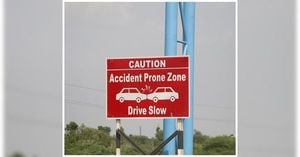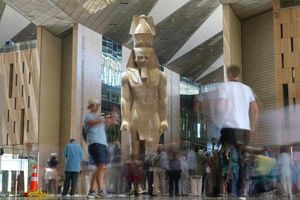For many in the United Kingdom, the Northern Lights have long felt like a distant spectacle reserved for the far reaches of the Arctic. Yet, in recent months, stargazers across the UK have been treated to a string of unexpectedly strong auroral displays, lighting up the night sky with bursts of green, red, yellow, and blue. As September 2025 unfolds, the excitement has only grown, with experts forecasting that the aurora borealis could be visible much further south than usual—maybe even to those who have never before caught a glimpse.
The Northern Lights, or aurora borealis, are a natural phenomenon that occurs when electrons from the solar wind collide with the Earth's atmosphere. These collisions excite atmospheric gases, causing them to emit light in a dazzling array of colors. According to the BBC, while the aurora is most commonly seen in high-latitude regions like Lapland in Northern Scandinavia, recent solar activity has made it possible for those in the UK to join in the spectacle.
But can you really see the Northern Lights with the naked eye in the UK? The answer, as meteorologists point out, is not always straightforward. The BBC notes that the Northern Lights are "not always visible to the naked eye," and experts often recommend using long exposure cameras to capture the full vibrancy of the display. In places closer to the poles, such as Lapland, the lights tend to appear brighter and more frequently. In contrast, in Scotland and Northern England—regions further from the poles—the aurora is harder to spot without photographic assistance. This is why many images circulating on social media look more spectacular than what the eye can see in real time.
Still, something special is happening this September. The Met Office, the UK's national weather service, has revealed that the conditions are ripe for a rare and widespread auroral event. This week, a fast-moving coronal mass ejection (CME) left the Sun late on Saturday, August 30, 2025, and was expected to hit Earth on the night of Monday, September 1. These charged particles are set to trigger a geomagnetic storm, which in turn could create colorful aurora displays across the globe—including much of the UK.
In a blog post, the Met Office explained, "With the arrival of this CME, the Met Office expects that at the peak of geomagnetic activity, there is a chance aurora may be visible across much of the UK. Notably, these displays may be visible to the naked eye, without the need for photographic equipment, which is relatively rare for locations this far south in the UK." For those in East Anglia, the Midlands, and Wales, this could be a once-in-a-lifetime opportunity, provided the skies remain dark and clear.
The timing of this celestial show is crucial. The Met Office's aurora maps suggest that the best chance to catch a view of the Northern Lights is between 9pm on September 1 and midnight, with visibility possible until around 3am on September 2. While the brightest aurora is likely to be seen in northern parts of Scotland, cloud cover could impact visibility. In fact, the Midlands were forecasted to have the least cloud and the best viewing conditions on September 1, while northern Scotland and northern England are likely to have the clearest skies on the evenings of September 2 and 3.
For those hoping to witness the spectacle, the advice is simple: find a clear, dark sky away from city lights. Photography can help reveal the vibrant colors if the aurora is faint to the naked eye. As Krista Hammond, Manager at the Met Office Space Weather Operations Centre, put it, "As we monitor the arrival of this coronal mass ejection, there is a real possibility of aurora sightings further south than usual on Monday night. While the best views are likely further north, anyone with clear, dark skies should keep an eye out. Forecasts can change rapidly, so we encourage the public to stay updated with the latest information."
The science behind this uptick in auroral activity is both fascinating and reassuring. The Met Office explains that the Sun's activity varies over roughly an 11-year period, known as the solar cycle. Krista Hammond elaborated, "Activity on the sun, and in particular the number of visible sunspots, varies over roughly an 11-year period, known as the solar cycle. Over the coming years, as we continue towards the solar maximum, we can expect to see an increase in the frequency of space weather events, with more chances to see the Aurora Borealis over the UK." In other words, the recent surge in Northern Lights sightings is not a fluke, but part of a predictable pattern tied to our star's ever-changing moods.
Of course, catching the aurora is never a guarantee. Even with perfect solar conditions, local weather plays a crucial role. The Met Office cautions that cloud cover can quickly dash hopes, especially in regions where the aurora is already faint. On September 1, the Midlands were expected to offer the best shot, but as the week progresses, the clearest skies are likely to shift northward. For those determined to see the lights, flexibility and patience are key.
For many in the UK, these recent and upcoming displays have sparked renewed interest in the wonders of the night sky. Social media has been awash with photos and videos—some taken with professional equipment, others snapped on smartphones—showing the aurora shimmering above familiar landmarks. While some viewers express disappointment that the lights look less vivid in person, the sense of awe is universal. The BBC and Met Office both remind would-be aurora hunters that photographic technology can amplify colors that the human eye struggles to perceive, especially in the less-than-ideal viewing conditions of southern Britain.
Looking ahead, experts predict that as the solar maximum approaches, the UK may see more frequent and intense auroral events. For now, though, all eyes are on the skies this week, with many hoping that a break in the clouds will reveal nature's own light show. Whether you catch the aurora in all its glory or simply enjoy the anticipation, it's a reminder that even in an age of screens and artificial lights, the universe still has a few surprises up its sleeve.
As the solar cycle continues, and with the next few nights holding promise, the UK stands ready for another brush with the extraordinary—one that brings the magic of the far north just a little closer to home.




